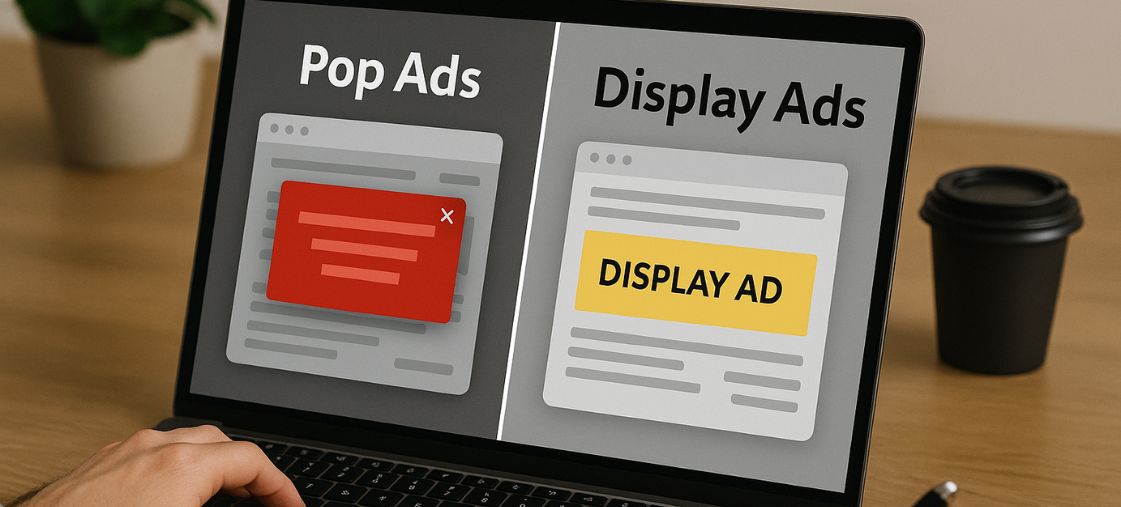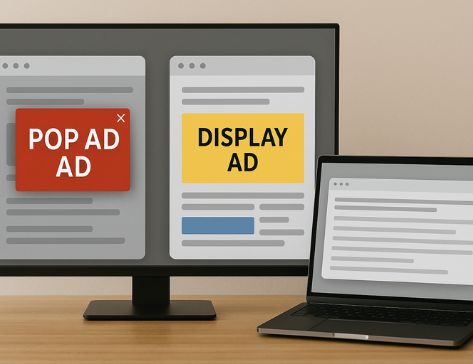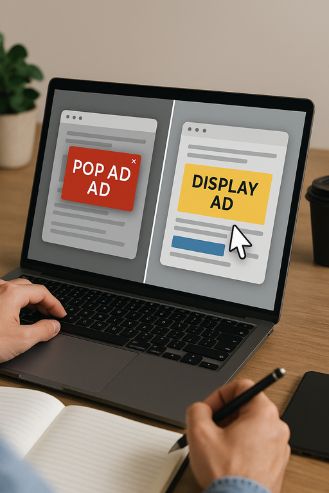
7 Pop Ad Copy Formulas Proven to Increase CTR
Pop ad copy is the lever that turns fleeting interruptions into high‑intent clicks, and mastering it can transform your campaign economics overnight.
Unlike display units that are passively scrolled past, pop ads command attention the instant they appear—so your words must be ultra clear, fast, and value‑dense. If you’re aiming to beat CTR benchmarks and scale profitably, you need frameworks that consistently compress your offer, proof, and urgency into a single, skimmable burst.
Because pop inventory differs from standard banners in user intent and timing, your messaging approach should, too. If you’ve ever wondered whether to lean on curiosity, clarity, proof, or urgency, you’ll find guidance below—plus a quick perspective on pop ads vs. display ads for affiliates and performance marketers.

How to Use This Guide
This isn’t a list of clever slogans. It’s a toolbox. For each formula, you’ll get: when it works, how to write it, a plain‑English template, concrete examples, and testing ideas. Start with two formulas that best fit your funnel stage and audience, launch variations, then cross‑pollinate winning elements into a hybrid.
The 7 Pop Ad Copy Formulas (With Steps, Templates, and Examples)
1) Problem → Agitate → Relieve (PAR), adapted for pops
When it works: Cold or mixed‑intent traffic where a sharp pain point can be named quickly.
- State the core problem in 3–6 words.
- Agitate with a specific consequence or cost.
- Relieve by promising a concrete, near‑term outcome.
- Call to action that matches the next step (scan, claim, fix, unlock).
Examples:
- “Still slow checkout? It’s leaking 18% of orders. Fix it today with TurboCart. See how.”
- “Bloated CPAs? Each week steals budget. Cut them in 7 days with SmartRules. Try free.”
Pro tips: Keep the agitation factual (metrics, time, money). Pops are intrusive—avoid fear mongering; clarity beats drama.
2) The 1‑2‑3 Clarity Formula
When it works: Warm traffic, comparison shoppers, or users in decision mode.
- 1: Who it’s for (role, niche, or device context).
- 2: What it does (one outcome, not a feature list).
- 3: Why now (risk‑free, scarcity, or speed).
- “For Shopify stores, BoostIQ lifts checkout conversion—in days. Start free.”
- “For iOS gamers, AdShield blocks lag—instantly. Download free.”
Pro tips: If you only remember one thing for pop ad copy, remember this: clear > clever. Name the audience, promise one outcome, add a low‑friction next step.
3) Benefit + Specificity + Urgency (BSU)
When it works: Direct‑response offers with measurable outcomes.
- Benefit: Choose the single most valuable payoff.
- Specificity: Add numbers, timeframes, or niche qualifiers.
- Urgency: Use a credible reason (seasonal, capacity, limited beta).
- “Grow trial‑to‑paid by 22% in 30 days—beta closes Friday. Request invite.”
- “Cut server costs 28% in 2 weeks—capacity is limited. Book a 10‑min audit.”
Pro tips: If you can’t substantiate urgency, swap it for speed (“in minutes,” “today,” “this week”) or friction removal (“no code,” “no credit card”).
4) Micro‑Proof Stack
When it works: Skeptical audiences, new products, or categories with scammy competitors.
- Start with a tiny win (a stat or short testimonial snippet).
- Add a recognizable brand (logo or name) if possible.
- Layer a safety signal (free trial, refund, cancel anytime).
- “Trusted by 1,200+ stores. ‘Checkout finally feels instant.’ Try free—cancel anytime.”
- “Used by indie devs and studios. ‘Cut crash rates 31%.’ Free for 14 days.”
Pro tips: In a pop context, brevity is credibility. Trim proof to its sharpest edge: number + noun + safety.
5) Curiosity Gap + Safety Net
When it works: Top‑of‑funnel discovery, tools with novel mechanisms, or content offers.
- Create a knowledge gap with a bold but plausible claim.
- Show the risk is minimal with a non‑committal CTA or free preview.
- Promise closure fast (e.g., “in 60 seconds,” “in one click”).
- “Most product pages leak this 1 fix. See yours in 60 seconds—no signup.”
- “Most UA teams overpay for the same installs. Prove it in one click.”
Pro tips: Don’t oversell the mystery; the reveal must feel inevitable in retrospect. Pair with an instant demo or calculator.
6) Loss Aversion Nudge
When it works: Renewal flows, abandoned carts, limited‑time promos, or capacity‑bound services.
- Name the at‑risk value (discount, data, spot, benefit).
- Highlight imminence with a near deadline or countdown.
- Offer a friction‑free save (restore, claim, reserve).
- “Your 20% launch discount expires in 3 hours. Keep it in 1 click.”
- “This week’s content brief slot is almost gone. Reserve yours now.”
Pro tips: Use timers sparingly in pops; false urgency backfires. Where possible, tie the loss to a real constraint.
7) Context Personalization (Device/Geo/Timing)
When it works: Broad audiences where relevance can be boosted with contextual hints.
- Detect a context (OS, browser, city, time of day, referrer).
- Mirror it in the copy to signal “for me.”
- Connect to a micro‑benefit that context implies.
- “Late‑night shopper in Austin? Get 2‑hour courier delivery—ends at midnight.”
- “On Chrome? Block high‑CPU scripts and browse 32% faster.”
Pro tips: Don’t get creepy. Use lightweight context (device/time/city) and tie it to something obviously helpful.
Writing Workflow: From Blank Screen to High‑CTR Pop in 10 Minutes
- Clarify the one outcome that matters (metric moved, pain solved).
- Choose a formula that matches your audience’s awareness and urgency.
- Draft three 20‑word variants—force brevity, then add only what improves clarity.
- Attach proof or safety (number, quote, guarantee, free trial) in 5–8 words.
- Match the CTA to the page (“See demo,” “Scan site,” “Unlock offer,” not generic “Learn more”).
- Read aloud; if you stumble, simplify. Pops are speed‑read.
- Does the first 5 words pass the “so what?” test?
- One promise only—no feature salad.
- Numbers beat adjectives (“22% faster” > “super fast”).
- Safety visible (free, cancel, refund) if asking for any commitment.
- CTA names the next step users actually take on the landing page.
- Mobile view: line breaks keep key phrases intact.
Testing Plan: Turn Formulas into Winners
Tip: Treat each formula like a hypothesis. Ship small, measure fast, then combine the best elements.
- Pick 2 formulas that fit intent (e.g., PAR vs. 1‑2‑3 for mid‑funnel).
- Create 3 variants each (swap benefit, proof, or timeframe).
- Standardize images/placement so copy is the variable.
- Measure CTR, post‑click rate (bounce/scroll), and primary conversion.
- Promote winners into always‑on sets; retire underperformers.
- Hybridize: e.g., 1‑2‑3 structure with Micro‑Proof or BSU numbers.
Common Mistakes to Avoid
- Over‑promising: Pops amplify claims; keep them provable.
- Feature dumping: One promise per pop. Link out for details.
- Generic CTAs: Vague “Learn more” wastes the click you just earned.
- Wall‑of‑text: 14–24 words is a sweet spot for scannability.
- Ignoring context: Device/time/location can improve relevance without creepiness.
Conclusion
Pop ad copy rewards clarity, specificity, and proof. Start with the 1‑2‑3 Clarity Formula and PAR, then layer BSU numbers or a Micro‑Proof Stack as your validation grows. As you iterate, keep your message short, your promise sharp, and your CTA aligned with the landing page. Want more inspiration? Study live winners in your niche using competitive research tools—platforms like pop ad spy libraries can reveal common angles, proof points, and CTAs that consistently convert. Ship fast, learn faster, and your CTR will follow.


